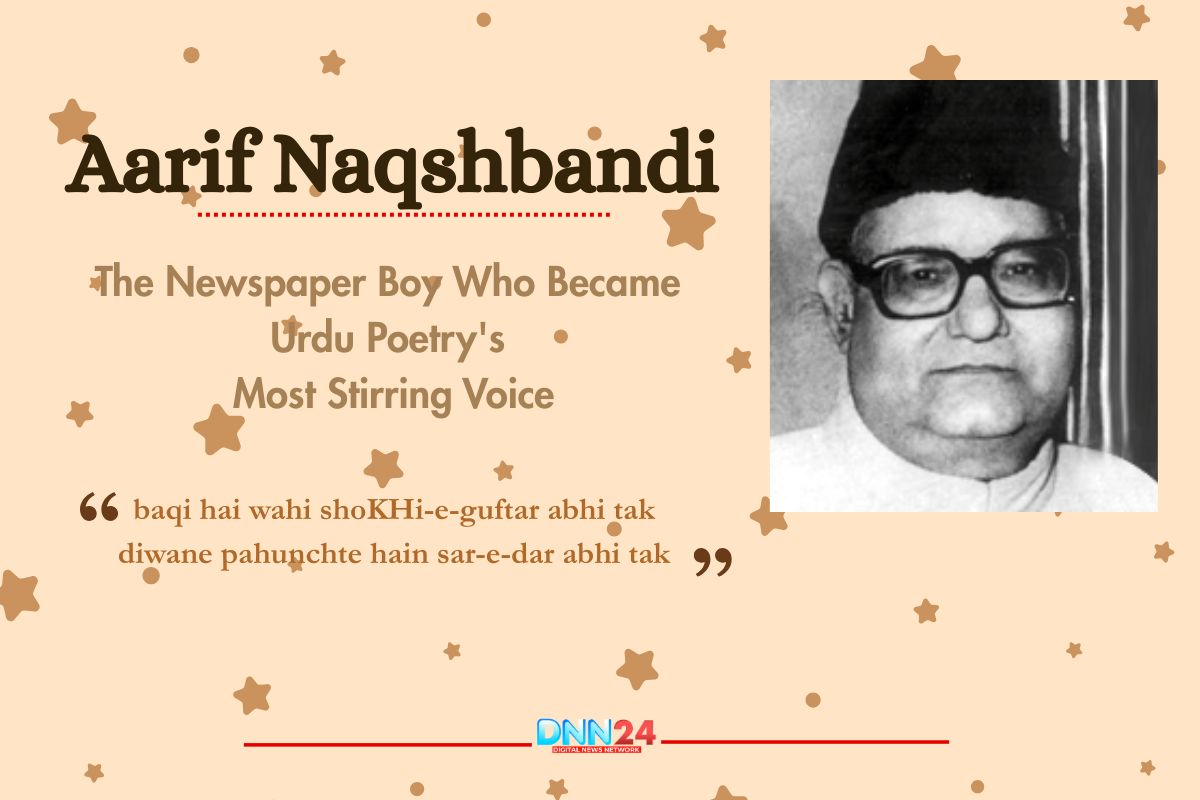Aarif Naqshbandi sold newspapers at railway stations before his poetry started healing wounds and building bridges across divided communities nationwide.
When Words Became Survival: The Beginning Years
Aarif Naqshbandi grew up in a household where poetry was passed down through whispered recitations. Those evening gatherings, lit by a single flickering lantern, introduced him to ghazals that spoke of longing and faith. His childhood was different from most. While other children played cricket in narrow lanes, Aarif found himself drawn to dusty bookshops, running his fingers along spines of ancient Urdu collections.
ye mohabbat ka sila tha ishq ka anjam tha
Aarif Naqshbandi
phul ka hansna hi us ki maut ka paigham tha
He would sit cross-legged on cold floors, scribbling thoughts on whatever paper he could find. School was difficult for him. Teachers saw an average student who preferred writing stories over solving mathematics. They never understood that every language assignment became his personal stage. When his father fell seriously ill, everything changed. At the age of ten, Aarif began selling newspapers at railway stations.
dekha tha kis nazar se tum ne hansi hansi mein
Aarif Naqshbandi
ek dard-e-mustaqil hai ab meri zindagi mein
Early mornings meant rushing between platforms, calling out headlines, and collecting coins. But something unexpected happened during those sales. He began listening. Passengers spoke in different dialects, using phrases he had never heard. Tea vendors shared stories between trains.
isi surat se taskin-e-dil-e-nashad karte hain
Aarif Naqshbandi
abhi tak yaad aate ho abhi tak yaad karte hain
These fragments became his education. His grandmother, a keeper of Sufi tales, filled his evenings with stories of saints and miracles. She taught him that suffering was temporary, but words could last forever. Teachers told him poetry was impractical. His response was silence, followed by more writing.
Breaking Through Barriers: The Years Nobody Talks About
Adolescence brought Aarif face-to-face with reality’s harshest lessons. Money remained scarce. Dreams felt distant. He took whatever work came his way, spending long hours waiting tables at roadside dhabas where truck drivers and travellers stopped for meals. The experience taught him about ordinary lives, the quiet heroism of daily survival.
phulon ki chand taron ki mahfil fareb hai
Aarif Naqshbandi
rangin haqiqaton mein bhi shamil fareb hai
He copied poetry by hand for local recitation events, earning barely enough to support his family. These were not wasted years. Every conversation he overheard, every tired face he served, every story shared over chai became material for his verses. One night changed his perspective entirely. Walking home from a poetry gathering, he witnessed a communal argument turning violent in his neighbourhood.
bahr-e-hasti se bhi ji ghabra gaya
Aarif Naqshbandi
be-kasi bas ab kinara aa gaya
People shouted. Anger spread like wildfire. Aarif went home and wrote through the night. The next evening, he stood in that same street and recited a poem about brotherhood. His words, sincere and straightforward, caused people to pause. Some cried. Others embraced. The anger dissolved. This incident revealed poetry’s true power to him. His first book, “Aqeedat Ke Phool”, emerged from these experiences.
kamal-e-ishq mein soz-e-nihan baqi nahin rahta
Aarif Naqshbandi
bhaDak jate hain jab sho’le dhuan baqi nahin rahta
The collection celebrated Sufi traditions, devotional themes, and spiritual wisdom that have been passed down through generations. Critics noticed his ability to make classical forms feel contemporary. He attended mushairas whenever possible, often uninvited, standing at the back until someone gave him a chance to recite. His verses used everyday language, making Urdu poetry accessible to audiences who found traditional styles intimidating.
Stories That Shaped a Poet’s Soul
College brought new challenges and unexpected moments of grace. Aarif applied for a literary scholarship and was rejected. Instead of retreating, he organised charity poetry readings to help struggling classmates pay their fees. Word spread across campus. Students who barely knew Urdu attended his sessions, drawn by his genuine care for others. At one prestigious mushaira, he arrived without an invitation.
mujh par teri nazron ka jo ehsan nahin hota
Aarif Naqshbandi
hathon se mere chaak gareban nahin hota
Security almost turned him away. Somehow, he convinced them to let him recite one poem. He chose verses about losing someone dear. The audience, expecting polished performances, heard raw emotion instead. Several people wept openly. That night, strangers approached him, sharing their own losses, thanking him for giving voice to their grief. These experiences taught Aarif that poetry was not about literary awards or critical acclaim.
kanTon pe chal raha hun mohabbat ki rah mein
Aarif Naqshbandi
kis husn ki bahaar hai meri nigah mein
It was about connection, about making people feel less alone. He faced many rejections from poetry competitions and scholarly journals. Each disappointment hurt, but he learned to transform pain into creative fuel. During a challenging period, he visited Sufi shrines in search of peace. At one dargah, a caretaker noticed his troubled expression.
husn-o-ulfat sath hain aaghaz se anjam tak
Aarif Naqshbandi
mera afsana suna jaega tere nam tak
They talked for hours. Before Aarif left, the older man gave him a worn notebook. He said to fill it with verses written for his own soul, not for an audience. That notebook became the foundation for his most important work, blending personal emotion with social observation and spiritual depth.
Why His Words Continue to Matter
Aarif Naqshbandi’s poetry refuses easy categorisation. His verses emerge from everyday struggles but bloom with uncommon grace. Reading his work feels like listening to a trusted friend during difficult times. His collections, particularly “Aqeedat Ke Phool,” showcase imagery that stays with readers long after the page turns. He writes about overcoming hardship without glorifying suffering.
husn ki jitni baDhin ranaiyan
Aarif Naqshbandi
‘ishq ke sar ho gain ruswaiyan
His ghazals explore loss but always circle back to resilience. Faith appears in his work not as a rigid doctrine but as gentle companionship through the nights. Critics praise his conversational tone, the way his poems feel like intimate conversations rather than formal declarations. This accessibility has enabled his work to transcend traditional Urdu poetry circles. Schools use his verses to teach empathy.
tasawwur mein ye kaun aaya zaban par kis ka nam aaya
Aarif Naqshbandi
nashat-e-ruh ka har ek nafas le kar payam aaya
Social campaigns quote his lines to promote communal harmony. Young writers study his style, learning how simplicity can carry profound weight. Aarif remains actively involved in his community, conducting poetry workshops for children in underserved areas. He teaches rhyme and meter to kids still learning to read, insisting their stories deserve to be heard.
hijr ki be-tabiyan thin hasraton ka josh tha
Aarif Naqshbandi
husn ka aaghosh phir bhi husn ka aaghosh tha
His journey from selling newspapers to inspiring thousands proves that creativity can flourish in the harshest conditions. True greatness, his life suggests, grows slowly through seasons of struggle, patience, and unwavering commitment to one’s voice. Aarif Naqshbandi stands as proof that poetry can still heal, unite, and transform lives in our fractured times.
Also Read: Saqi Farooqi: The Rebel Poet Who Kept Urdu Alive in London
You can connect with DNN24 on Facebook, Twitter, and Instagram and subscribe to our YouTube channel.

